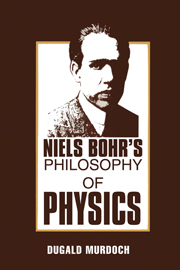Book contents
- Frontmatter
- Contents
- Dedication
- Preface
- Acknowledgements
- 1 Wave-particle duality
- 2 Niels Bohr and wave-particle duality
- 3 From duality to complementarity
- 4 The meaning of complementarity
- 5 The foundations of kinematic-dynamic complementarity
- 6 Bohr's theory of measurement
- 7 Bohr's theory of properties
- 8 Einstein versus Bohr
- 9 The sequel to the Bohr-Einstein debate
- 10 Bohr's philosophy of physics
- 11 An appraisal of Bohr's philosophy of physics
- Notes
- Index
9 - The sequel to the Bohr-Einstein debate
Published online by Cambridge University Press: 01 June 2011
- Frontmatter
- Contents
- Dedication
- Preface
- Acknowledgements
- 1 Wave-particle duality
- 2 Niels Bohr and wave-particle duality
- 3 From duality to complementarity
- 4 The meaning of complementarity
- 5 The foundations of kinematic-dynamic complementarity
- 6 Bohr's theory of measurement
- 7 Bohr's theory of properties
- 8 Einstein versus Bohr
- 9 The sequel to the Bohr-Einstein debate
- 10 Bohr's philosophy of physics
- 11 An appraisal of Bohr's philosophy of physics
- Notes
- Index
Summary
The EPR paper and Bohr's reply to it brought to an end the public debate between Einstein and Bohr. In the aftermath, Bohr's construal of quantum mechanics established itself as the basis of the orthodox interpretation – the ‘Copenhagen interpretation’ as it came to be called. The vast majority of physicists regarded Einstein's criticism as reactionary, and dismissed it with disdain. One of the main causes of this disdainful attitude was the general opinion that Einstein's criticism committed him to the existence of hidden states, and the existence of these, it was thought, had been conclusively ruled out by the work of von Neumann and others. What light does the subsequent work on the question of hidden states, and in particular the work of Bell, throw on the Bohr–Einstein dispute?
Completeness and hidden states
There are three distinct questions concerning hidden states. First, might there be such states, unbeknown to quantum mechanics? Second, can quantum mechanics, as it stands, take account of such states? Third, could some theory containing descriptions of such states reduplicate the predictions of quantum mechanics? Concerning the first of these questions, Einstein's view was that it is very likely that such states exist, and since quantum mechanics takes no account of them, it is incomplete and best regarded as a statistical theory analogous in some respects to classical statistical mechanics.
- Type
- Chapter
- Information
- Niels Bohr's Philosophy of Physics , pp. 179 - 199Publisher: Cambridge University PressPrint publication year: 1987
- 1
- Cited by



